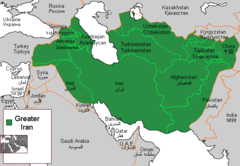泛伊朗主義
外观

泛伊朗主義(英語:Pan-Iranism,波斯語:پانایرانیسم)是一種存在於中亞地區的意識形態,旨在提倡居住於伊朗高原及其它經受伊朗文化影響之地域的伊朗民族之間的團結與統一。這一概念涉及到多個族群,包括波斯人、阿塞拜疆人、奥塞梯人、库尔德人與扎扎人;分佈在塔吉克斯坦、烏兹別克斯坦與阿富汗的塔吉克人;以及巴基斯坦的普什圖人和俾路支人。最早提出這一理論的是一位叫做穆罕默德·阿夫沙兒·亞兹迪(Mahmoud Afshar Yazdi)的學者。[2][3][4][5][6][7]
參考資料
[编辑]- ^ IRAN i. LANDS OF IRAN. Encyclopædia Iranica. [2017-07-09]. (原始内容存档于2016-05-17).
- ^ Professor Richard Frye states:The Turkish speakers of Azerbaijan are mainly descended from the earlier Iranian speakers, several pockets of whom still exist in the region (Frye, Richard Nelson, “Peoples of Iran”, in Encyclopedia Iranica).
- ^ Swietochowski, Tadeusz. “ AZERBAIJAN , REPUBLIC OF”,., Vol. 3, Colliers Encyclopedia CD-ROM, 02-28-1996: “The original Persian population became fused with the Turks, and gradually the Persian language was supplanted by a Turkic dialect that evolved into the distinct Azerbaijani language.”
- ^ Golden, P.B. “An Introduction to the History of the Turkic Peoples”,Otto Harrosowitz, 1992. “The Azeris of today are an overwhelmingly sedentary, detribalized people. Anthropologically, they are little distinguished from the Iranian neighbo”
- ^ Xavier Planhol, “Lands of Iran” in Encyclopedia Iranica. Excerpt: The toponyms, with more than half of the place names of Iranian origin in some areas, such as the Sahand, a huge volcanic massif south of Tabriz, or the Qara Dagh, near the border (Planhol, 1966, p. 305; Bazin, 1982, p. 28) bears witness to this continuity. The language itself provides eloquent proof. Azeri, not unlike Uzbek (see above), lost the vocal harmony typical of Turkish languages. It is a Turkish language learned and spoken by Iranian peasants.”(Encyclopedia Iranica, “Lands of Iran”)
- ^ “Thus Turkish nomads, in spite of their deep penetration throughout Iranian lands, only slightly influenced the local culture. Elements borrowed by the Iranians from their invaders were negligible.”(X.D. Planhol, LANDS OF IRAN in Encyclopedia Iranica)
- ^ История Востока. В 6 т. Т. 2. Восток в средние века. Глава V. — М.: «Восточная литература», 2002. — ISBN 5-02-017711-3 . Excerpt: ""Говоря о возникновении азербайджанской культуры именно в XIV-XV вв., следует иметь в виду прежде всего литературу и другие части культуры, органически связанные с языком. Что касается материальной культуры, то она оставалась традиционной и после тюркизации местного населения. Впрочем, наличие мощного пласта иранцев, принявших участие в формировании азербайджанского этноса, наложило свой отпечаток прежде всего на лексику азербайджанского языка, в котором огромное число иранских и арабских слов. Последние вошли и в азербайджанский, и в турецкий язык главным образом через иранское посредство. Став самостоятельной, азербайджанская культура сохранила тесные связи с иранской и арабской. Они скреплялись и общей религией, и общими культурно-историческими традициями." (History of the East. 6 v. 2. East during the Middle Ages. Chapter V. - M.: «Eastern literature», 2002. - ISBN 5-02-017711-3.). Translation:"However, the availability of powerful layer of Iranians took part in the formation of the Azerbaijani ethnic group, left their mark primarily in the Azerbaijani language, in which a great number of Iranian and Arabic words. The latter included in the Azeri, and Turkish language primarily through Iranian mediation."
